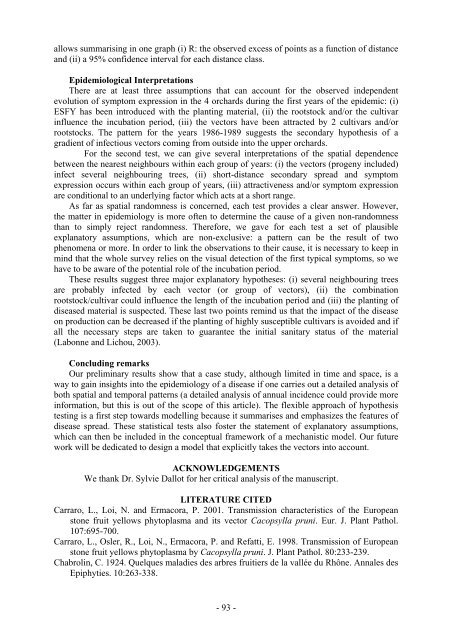Ecole Nationale Supérieure Agronomique de Montpellier ... - CIAM
Ecole Nationale Supérieure Agronomique de Montpellier ... - CIAM
Ecole Nationale Supérieure Agronomique de Montpellier ... - CIAM
You also want an ePaper? Increase the reach of your titles
YUMPU automatically turns print PDFs into web optimized ePapers that Google loves.
allows summarising in one graph (i) R: the observed excess of points as a function of distance<br />
and (ii) a 95% confi<strong>de</strong>nce interval for each distance class.<br />
Epi<strong>de</strong>miological Interpretations<br />
There are at least three assumptions that can account for the observed in<strong>de</strong>pen<strong>de</strong>nt<br />
evolution of symptom expression in the 4 orchards during the first years of the epi<strong>de</strong>mic: (i)<br />
ESFY has been introduced with the planting material, (ii) the rootstock and/or the cultivar<br />
influence the incubation period, (iii) the vectors have been attracted by 2 cultivars and/or<br />
rootstocks. The pattern for the years 1986-1989 suggests the secondary hypothesis of a<br />
gradient of infectious vectors coming from outsi<strong>de</strong> into the upper orchards.<br />
For the second test, we can give several interpretations of the spatial <strong>de</strong>pen<strong>de</strong>nce<br />
between the nearest neighbours within each group of years: (i) the vectors (progeny inclu<strong>de</strong>d)<br />
infect several neighbouring trees, (ii) short-distance secondary spread and symptom<br />
expression occurs within each group of years, (iii) attractiveness and/or symptom expression<br />
are conditional to an un<strong>de</strong>rlying factor which acts at a short range.<br />
As far as spatial randomness is concerned, each test provi<strong>de</strong>s a clear answer. However,<br />
the matter in epi<strong>de</strong>miology is more often to <strong>de</strong>termine the cause of a given non-randomness<br />
than to simply reject randomness. Therefore, we gave for each test a set of plausible<br />
explanatory assumptions, which are non-exclusive: a pattern can be the result of two<br />
phenomena or more. In or<strong>de</strong>r to link the observations to their cause, it is necessary to keep in<br />
mind that the whole survey relies on the visual <strong>de</strong>tection of the first typical symptoms, so we<br />
have to be aware of the potential role of the incubation period.<br />
These results suggest three major explanatory hypotheses: (i) several neighbouring trees<br />
are probably infected by each vector (or group of vectors), (ii) the combination<br />
rootstock/cultivar could influence the length of the incubation period and (iii) the planting of<br />
diseased material is suspected. These last two points remind us that the impact of the disease<br />
on production can be <strong>de</strong>creased if the planting of highly susceptible cultivars is avoi<strong>de</strong>d and if<br />
all the necessary steps are taken to guarantee the initial sanitary status of the material<br />
(Labonne and Lichou, 2003).<br />
Concluding remarks<br />
Our preliminary results show that a case study, although limited in time and space, is a<br />
way to gain insights into the epi<strong>de</strong>miology of a disease if one carries out a <strong>de</strong>tailed analysis of<br />
both spatial and temporal patterns (a <strong>de</strong>tailed analysis of annual inci<strong>de</strong>nce could provi<strong>de</strong> more<br />
information, but this is out of the scope of this article). The flexible approach of hypothesis<br />
testing is a first step towards mo<strong>de</strong>lling because it summarises and emphasizes the features of<br />
disease spread. These statistical tests also foster the statement of explanatory assumptions,<br />
which can then be inclu<strong>de</strong>d in the conceptual framework of a mechanistic mo<strong>de</strong>l. Our future<br />
work will be <strong>de</strong>dicated to <strong>de</strong>sign a mo<strong>de</strong>l that explicitly takes the vectors into account.<br />
ACKNOWLEDGEMENTS<br />
We thank Dr. Sylvie Dallot for her critical analysis of the manuscript.<br />
LITERATURE CITED<br />
Carraro, L., Loi, N. and Ermacora, P. 2001. Transmission characteristics of the European<br />
stone fruit yellows phytoplasma and its vector Cacopsylla pruni. Eur. J. Plant Pathol.<br />
107:695-700.<br />
Carraro, L., Osler, R., Loi, N., Ermacora, P. and Refatti, E. 1998. Transmission of European<br />
stone fruit yellows phytoplasma by Cacopsylla pruni. J. Plant Pathol. 80:233-239.<br />
Chabrolin, C. 1924. Quelques maladies <strong>de</strong>s arbres fruitiers <strong>de</strong> la vallée du Rhône. Annales <strong>de</strong>s<br />
Epiphyties. 10:263-338.<br />
- 93 -



